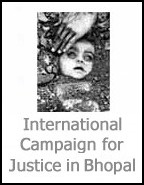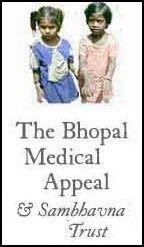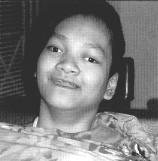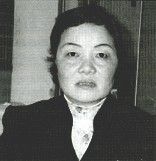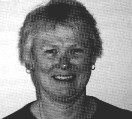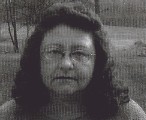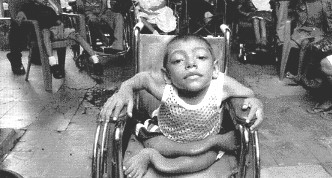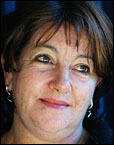Dow has profited from the contamination and suffering of thousands of people around the globe. These are a few of their stories.
Huynh thi Phuong, Agent Orange
victim Pham thi Hao, Agent Orange victim Betty Damore, Michigan dioxin
victim Kathy Henry, Michigan dioxin
victim Juan Dominguez, Attorney for
Nemagon victims Flor de Maria Mendoza &
Jose Romero, Nemagon victims Cristobal Acetuno, Nemagon
victim Manuel Guido Montoya, Nemagon
victim Rhonda Bartle, New Zealand
dioxin victim
Tran thi Hong Ha "My husband worked and was exposed indirectly to unknown chemicals of US army from 1972-1976 in Quang Tri old citadel, Tay Ninh and Khe Sanh. He ate food and drank stream water in these regions.
"I was first pregnant in 1986 with a breech presentation. The foetal heart sound was lost during labour and the foetus died several hours before delivery. "My second daughter Hoang Ha My, born in 1987, is now 16 years old. The labor and delivery was normal. But at eight months of age we realised she had physical and mental growth retardation and the diagnosis was cerebral palsy. She stays in bed all day, cannot sit nor stand. She must be served everything in bed, including her personal hygiene. "In 1989 I was pregnant again but lost the baby in the second month. My fourth and fifth children are almost normal. "The illness of Hoang Ha My, brings upset to my whole family. We have faced many psychological and economic difficulties. Our life is really not stable. My family wants to represent ourselves and other families who have similar circumstances." Huynh thi Phuong "After graduating from Hanoi Medical University in 1965 I returned to the South and worked in a Vaccine Production Center in the Mid-Central area, located along Pui stream and Ngheu, Oa, Vin streams. "In 1969, when we were working in our lab, we smelt an unpleasant odor. We quickly ran out and saw a big airplane flying slowly over leaving a dense foggy cloud. We realized it was Agent Orange as just after several minutes, the leaves on the trees fell down. We had to rescue what we had cultivated for survival. "We rushed to our cassava garden and wallowed in the toxic air without thinking of the danger. All of us tried to save our products and we caught the toxic agent. We soaked our products in the stream nearby, but the stream was also toxic. We boiled cassava carefully to eat but the odor remained. "There was no other choice. Daily, we had to eat the foods in these areas. Weeks after that, trees around died. My friends Luong, Toan and Hung had haematoria. In 1972 due to a recurrent illness I went to the North for treatment. "I married in 1972 and had an underweight boy, but luckily he was normal. In 1979 I had a second child. Due to 12 tumors clinging to my uterus and ovaries, doctors had to perform caesarean and forceps procedure to deliver my baby. "They had to remove my entire uterus and ovaries due to these tumors. At that time we had no drugs (our country was isolated - closed) for maintaining the family life of a young couple. "My younger sister Huynh thi Phuong Anh, born in 1943, who lived and worked as bank officer in Quang Nam Province from 1968 to 1971 also had a uterine fibroid tumor which was removed in 1990 at Hanoi. "None of our relatives had this kind of disease. It was terrible. I condemn individuals who bring these consequences to me and my colleagues." Pham thi Hao
"As young volunteer, I worked as a road worker or a cook at Ashaw. Although I was not directly exposed to Agent Orange, I lived in the regions with dead trees. I used to forest vegetables like cassava, as foods and spring water. I fear I acquired exposure indirectly. "I was pregnant five times and had three miscarriages. From 1999 I was hospitalized in the Central Hospital of Obstetrics and Gynecology in Hanoi because of severe gynaenological complications and cancer. "I needed six courses of chemo-therapy. No cancer nor reproductive disorders were previously documented among my relatives." Betty Damore "I am 55 and have always lived on Stroebel road. I grew up here. The property we live on was owned by my grandfather. We are about a quarter of a mile back from the river. Our property is connected by Stroebel drain to the Tittabawassee River. As water levels change due to heavy rains or melting snow, the floodwaters flow into Stroebel drain flooding the back portion of our property. Sometimes we have 8 foot of water in our back yard.
"As a kid my family would mention the river was polluted. Dow was mentioned. You could see a yellow haze in the sky when you drove through Midland and you had to roll up your windows near Dow's factories. In February 2001 I heard about the dioxin levels around our properties. I had no doubts it was from Dow Chemical. "It is difficult to know whether health problems my family and I suffer are a consequence of the dioxin. However, it is known that dioxin may cause cancer, diabetes, hormonal problems, and a list of other problems. "Why do we have a clustering of individuals with a multiple sclerosis diagnosis and cancer? It is known that there are much higher incidents of thyroid problems in this community. "When the DEQ tested our neighborhood, the results showed levels from three parts per trillion total toxic equivalence (TEQ) by Stroebel Rd to 90 parts per trillion TEQ approximately 50 feet from the back of our property line. "Government departments have sent out serial newsletters with recommendations of what residents should do to limit their exposure to dioxin. We have not had a garden for three years because this area was flooded in the 1986 flood. As far as cutting grass, my husband always wears a mask. If there is a need to go to the end of our property line we wear boots and specific work clothes. "Less than a quarter of a mile from us people have levels of more than two thousand parts per trillion TEQ in their backyard. Their kids are older but they have young grandchildren that play in their backyard. Children are closer to the ground and they are more susceptible. "Dow representatives have mentioned people may not need to use their property entirely and if they are aware that area is contaminated don't use it. It is our property and we should be able to use it as we see fit. "We built our home here and put our life savings into our home. It is a nice area, close to work and shopping. We routinely see wild turkey, deer, and other wildlife. Our youngest is in high school so we have no intentions of moving at this time. "We may want to move in the future but because we live in the floodplain our property has been declared by the DEQ as a waste facility. Being a responsible property owner it is our moral responsibility to tell potential buyers about this dioxin contamination. "Our kids are aged 17 to 24. There should be a trust fund set up for medical monitoring. They are young now but what may occur in the future for them health wise remains to be seen. Our lifestyles have changed as a result of the contamination. "Dow continues to want more studies done. This has been an ongoing problem. Why duplicate studies that have already been done by state agencies. "Dow needs to address this problem and clean it up now. For two years there continues to be a dispute about how to warn people about the contamination on park signs. Needless to say innocent children, adults, and family pets continue to be exposed to dioxin. Dow suggested placing wood chips on frequently used areas in local parks but after the most recent flood those wood chips would have been washed away. Their solution is like putting a small bandage on a massive bleeding wound." Kathy Henry "My life changed forever the day I read a Saginaw newspaper article that local environmental groups had discovered state agencies had been withholding information about contamination of the Tittabawassee River with a dangerous toxin called dioxin. I had never heard of it before, but had a sick feeling in my stomach.
"You see, many years prior to this, I had come to suspect there was something very wrong with our property, but had no idea what. I am an avid wildlife and bird watcher, and had noticed there were basically no rabbits living around us even though we have perfect habitat for them. A stray one would show up once in awhile, but they were never around for long. "A species of woodpecker known to live in the area, a Flicker, who's primary diet is ants, never could seem to establish a population here, where other types who primarily ate other insects off of trees did well. "There seems to be no worms in the floodplain soils that I have dug up over the years. Some of the mice my cats would catch and bring home had large tumors in their livers. The two cats that ate a lot of mice also died of strange cancers. And of course there were the fish, walleye people would catch during the walleye festival that had tumors on them. "There are actually very few species that seem to thrive in this area, considering what should be here. "Over the past two years, I have attended many meetings and find it disturbing to hear the stories from many, many families that live on the river. There doesn't seem to be one household that does not have multiple illnesses in their families. Is this normal? "I feel that in the greater community, there is still much denial as to how bad the situation really is. People don't want to believe there is such a problem, for various reasons, and accept Dow's misinformation with open arms, hoping the problem will just go away. Sad. "After a year of trying to find answers and solutions from state agencies, environmental groups, politicians and even Dow, we felt our only option was to file a law suit against the polluter. It was obvious to us by then that we needed to protect ourselves. "We also fully support the environmental groups in their efforts to get Dow to clean up the contamination disaster they created. It is the only right thing to do. "This is an effort to correct something that is terribly wrong and needs to be fixed. "But for now, every day I wake up and look out into the yard that I once loved, felt tremendous joy in being here, and only feel sadness. I no longer care about the yard, flowers, birds and animals. When I see the flock of wild turkeys pecking on the ground looking for food, I want to cry. "The State of Michigan tested our yard, and the highest level of 12 samples they took, was 1130 parts per trillion TEQ." Juan Dominguez
"The DBCP was used and sprayed in wide swathes onto unsuspecting people who lived within and around the banana plantations, some of whom never even saw a DBCP barrel. "The law is clear that once you place a dangerous product in the stream of commerce, you are liable for harm caused, no matter where it is ultimately used. "The scientific evidence is abundantly clear that sterility is caused by DBCP. Moreover, there is ample scientific evidence that DBCP causes cancer and also birth defects. "[The companies] simply do not want to be responsible in any court, in any country, or in any forum... It is simple why they do not wish to defend themselves and it is because they know full well they will lose." Flor de Maria Mendoza & Jose Romero Flor de Maria Mendoza and her husband Jose Romero worked on banana plantations during the 1970s. They have four children. Two died at birth. Their 11 -year old daughter, Ana Maria, was born with physical deformities that do not allow her to walk, talk, or grasp. Ana's parents must feed her a constant supply of medicine to control her liver inflammation, frequent fevers, pneumonia, and diarrhea while Ana sits in a wheelchair, staring blankly into space. (2) Cristobal Acetuno Cristobal Acetuno picked and bagged bananas on plantations for eight years. He is now nearly blind, often feels nauseous, has no appetite and lives with rashes on his skin and lesions on his feet. Cristobal's two sons suffer from similar ailments that require medication, and his wife, also a former banana worker, has stomach cancer. Cristobal and his wife had been mistaking the cancerous tumor in her stomach for pregnancy until one day when she lost consciousness, she was rushed to the hospital, and underwent a nearly fatal operation that revealed her terminal disease. Manuel Guido Montoya Manuel Guido Montoya was unable to have the children he once hoped would ease his workload and bring home a few extra dollars. Years ago, he tried to start a family but the woman left him once she realized he was sterile. He says he and his co-workers were drenched in the pesticide. "Walking through the plantations, we breathed in the vapors, I'd get headaches, a bloody nose, stomach-aches...You put up with a lot of pain." (3) Rhonda Bartle I might have been a fiction writer in a former life, but these
days as a journalist, I mostly deal in facts. The fact is, I grew
up in the shadow of a Dow chemical factory, in the suburb of Paritutu,
New Plymouth, during all the dioxin years. I lived there from 1957 to 1971, from age 3 to 17 years. Our house was the first on Simons St. As the crow flies, it was the closest to the chemical plant - less than 500m away. The house number was 13, but it never struck anyone as being unlucky. Instead, it promised a blessed, good life in a new suburb, on a small but spectacular coastal peninsular, a short walk to the beach or down to the wharf to fish. Touted as a great place to raise a family, the suburb of Paritutu was indeed a kids' paradise. We chased pheasants through the lupins and picked lilies from the creeks. Ate blackberries off the bushes and sucked sourgrass stalks. We walked miles to school and dawdled home again. And the sun shone, as it always seems to do in retrospective childhood. At the time my father bought the property, the land was zoned residential. I still remember his frustration and anger when he was suddenly advised by the local council that everything over our back fence was to be re-zoned industrial. Meetings were held, he and other residents argued, but eventually re-zoning went ahead. We watched Ivon Watkins Dow Ltd grow box-like on our landscape, followed by VetMed Laboratories, Youngs Rubber Company and an oil tank farm. My father was very protective of his five daughters. He did his best to keep us safe. Yet never once was he privy to the dangers the Dow chemical plant imposed. I have all the anecdotes, as every child who grew up in that neighbourhood does. Of the foam that flew on a certain breeze and landed on the lawn, leaving burnt orange circles. Of native bushes that failed on one side. Of curtains that rotted against the sills. Of our mother crying: "Shut the windows. The wind has changed". Of visitors complaining of the all-invasive stench and wrinkling up their noses, not only at the smell, but at us crazy people, living within breathing distance of some chemical industry. Why didn't we move, they asked? "Where to?" our father, a postal worker, replied. Who could afford to move? Who would buy the house, anyway? No, this was it, he said, this was "our" house, and we were there for good. It can't be too bad or they wouldn't have let those buggers build that factory there. My father collected the empty chemical drums that lay around in their puddles of orange sludge, washed them and planted trees in them that wouldn't survive. Down on the sand at Back Beach, we walked in the waves where the oily slick from the effluent pipe left orange marks on our skin. Later, my mother served in the Dow canteen, bringing home left-over food. Everything delivered "tasted funny", but to kids of the 50s and 60s, a raspberry bun was a raspberry bun, a doughnut a doughnut. We ate the food, anyway. When she took on work as a cleaner at VetMed, those of us still at home took turns to help her scrub the black rubber boot marks off the floor. Miraculously, I escaped the explosion of 1972, though my parents and three of my sisters still lived close enough to eye-witness the blast. I have since learned that there have been two dozen such explosions around the world, and they are all listed as world dioxin-contaminated disasters, but nowhere will you find the Paritutu explosion recorded on a global map. Ignorance is not bliss, but then sometimes neither is higher learning. Here we are in 2006, and as a diminished family, we've come to understand what prolonged exposure to dioxin has done to us. Journalist Melanie Reid's remarkably easy to digest, but hard to stomach, 90-minute Let Us Spray documentary has aired (on TV3, October 23). Dioxin is all over the country, but this time it's in the news. Finally, there is fallout that's not coming air borne from the direction of IWD. It's been proven that the Government knew of the dangers and chose not to tell us. It's been proven they kept silent and then went so far as to actually manipulate data, gathered from Paritutu residents through serum testing, to ensure the wool was pulled completely over our eyes. The test process itself was flawed. Government policy seems to have been money over people. A multi-national company over native New Zealanders. The serum testing was nothing more than window dressing, damage control taken to new heights. Why are we surprised? This is the same Ministry of Health which expected us to be happy with the appointment of Professor Allan Smith to take a fresh new look at the study. Smith was caught on camera saying publicly how great he thought that serum study was. For the record, I didn't front up for the serum testing, as I already believed it was designed to do exactly what it did - let health officials off the hook instead of making them accountable. But I'll stand head of the line when it comes to DNA testing. I can no longer deny that dioxin from the Dow factory has damaged me in ways I couldn't see. Let's get personal here. I keep good health. I used to think, somehow, I'd escaped the dioxin threat. Yes, I had a sister who died of cancer at 36. Yes, she'd had a baby who died at 8 months gestation but was delivered full term. Yes, one of those photos taken by midwife Hyacinth Henderson - who suddenly found herself in the midst of a birth defect epidemic and got her camera out - was probably of my unknown and unnamed niece. And yes, my father died of heart disease at 59 and my mother of cancer a decade later, but me? Nope, not me. Never me. Somehow, I remained immune, as my own five children had. When advised by those in a position to know that my dioxin levels were likely to be higher than those of Vietnam vets directly sprayed with Agent Orange, I shook my head and dismissed the idea. Nope. Couldn't be. They said other awful things: if my levels turned out to be lower than expected, then it was probably because I'd breastfed all five of my babies, and dioxin is secreted through breast milk. "What do you mean?" I asked. Everyone knows that breast is best. Isn't it? Still, I filed all that away and tried to forget about it, which was fine until the next generation appeared. So, talk to me about intergenerational genetic damage. Ask me about heart defects and hydrocephalus, because I'm something of a pseudo-expert now. New members of our family have been born with the exact same conditions as those commonly found in third generation Vietnam vets. I put my hand up to be counted. This article appeared in the New Zealand Herald on November 12, 2006.
(1) Beachy, B. "Farmworkers wage legal battle against US companies that poisoned them." The Nicaragua Monitor, 2003. (2) ibid (3) Gonzales, D and Loewenberg, S. "Banana Workers Get Day in Court." New York Times, Jan. 18, 2003. Available at http://www.misko.com/library/BananaWorkersGetDayinC.pdf.
|
The international student campaign to hold Dow
accountable for Bhopal, and its other toxic legacies around the world.
For more information about the campaign, or for problems regarding this
website, contact Ryan
Bodanyi, the Coordinator of Students for Bhopal.
WE
ALL LIVE  IN
BHOPAL
IN
BHOPAL
"The year 2003 was a special year in the history of the campaign for justice in Bhopal. It was the year when student and youth supporters from at least 30 campuses in the US and India took action against Dow Chemical or in support of the demands of the Bhopal survivors. As we enter the 20th year of the unfolding Bhopal disaster, we can, with your support, convey to Dow Chemical that the fight for justice in Bhopal is getting stronger and will continue till justice is done. We look forward to your continued support and good wishes, and hope that our joint struggle will pave the way for a just world free of the abuse of corporate power."
Signed/ Rasheeda Bi, Champa Devi Shukla
Bhopal Gas Affected Women Stationery Employees Union
International Campaign for Justice in Bhopal
This is what the www.studentsforbhopal.org site looked like in early 2008. For more recent information, please visit www.bhopal.net.

